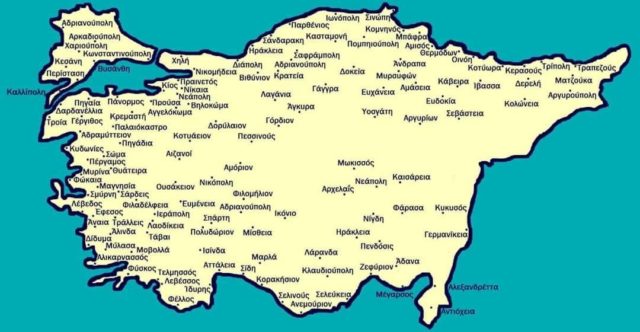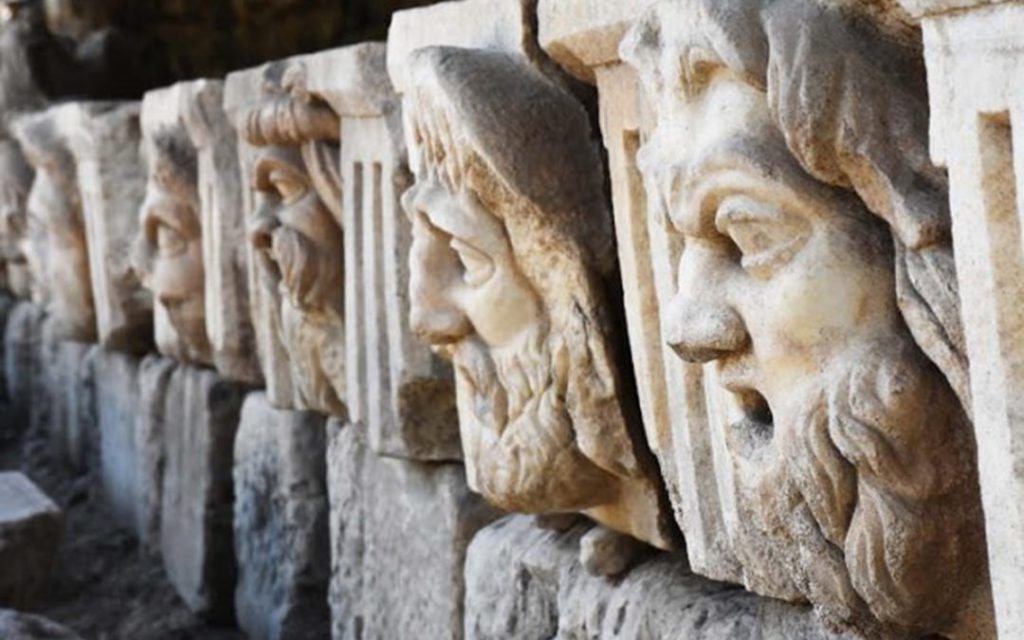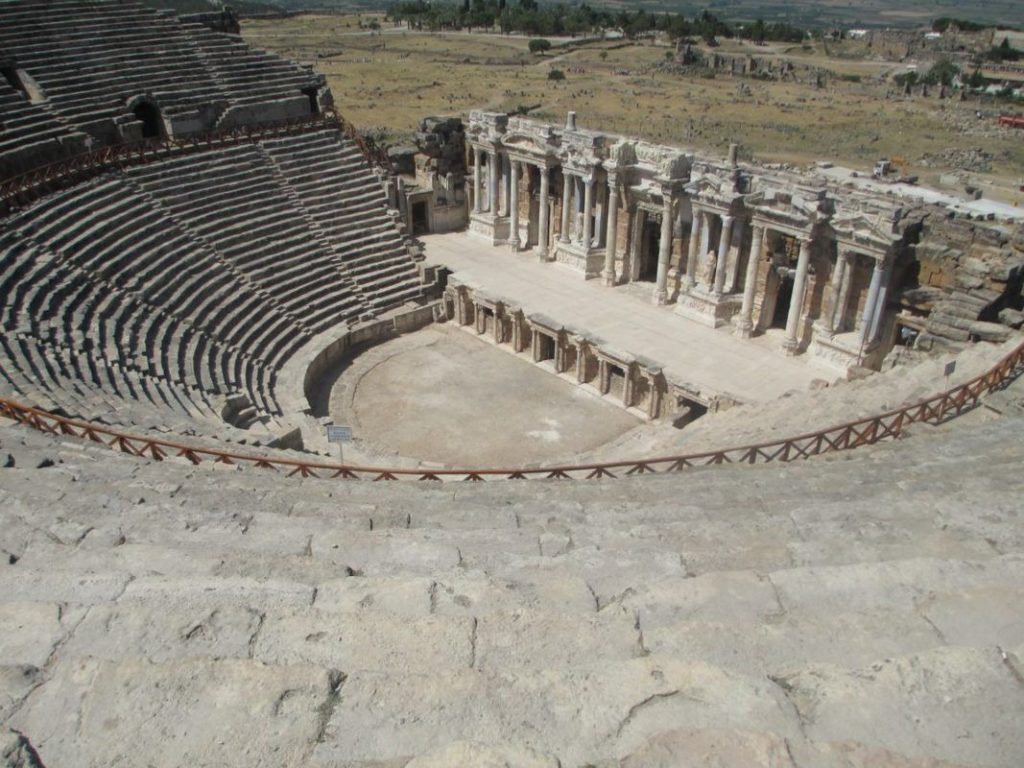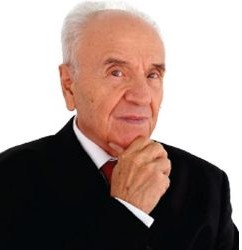Bust of Democritus. Villa of the Papyri.
Born c. 460 BC Abdera, Thrace
Era Pre-Socratic philosophy Region Western philosophy
School Atomism
Main interests Nature
Notable ideas Atoms and the void as the fundamental constituents of the physical world

Democritus (/dɪˈmɒkrɪtəs/, dim-OCK-rit-əs; Greek: Δημόκριτος, Dēmókritos, meaning “chosen of the people”; c. 460 – c. 370 BC) was an Ancient Greek pre-Socratic philosopher from Abdera, primarily remembered today for his formulation of an atomic theory of the universe.
FEW of Democritus’ original work has survived, MOST references. Many of these references come from ARISTOTELES, who viewed him as an important rival in the field of natural philosophy
Atomic hypothesis
See also: Atomism
We have various quotes from Democritus on atoms, one of them being:
δοκεῖ δὲ αὐτῶι τάδε· ἀρχὰς εἶναι τῶν ὅλων ἀτόμους καὶ κενόν, τὰ δ’ἀλλα πάντα
Δημόκριτος, DEMOKRITOS, meaning “chosen of the people”; c. 460 – c. 370 BC) was an ANCIENT-GREEK PRE-SOCRATIC philosopher from THRACE/ABDERA, primarily remembered today for HIS FORMULATION of an atomic theory of the universe.
Democritus knew that if a stone was divided in half, the two halves would have essentially the same properties as the whole.Therefore, he reasoned that if the stone were to be continually cut into smaller and smaller pieces then; at some point, there would be a piece which would be so small as to be indivisible. He called these small pieces of matter “atomos,” the Greek word for indivisible. Democritus, theorized that atoms were specific to the material which they composed. In addition, Democritus believed that the atoms differed in size and shape, were in constant motion in a void, collided with each other; and during these collisions, could rebound or stick together. Therefore, changes in matter were a result of dissociations or combinations of the atoms as they moved throughout the void. Although Democritus’ theory was remarkable, it was rejected by Aristotle, one of the most influential philosophers of Ancient Greece; and the atomic theory was ignored for nearly 2,000 years.
None of Democritus’ original work has survived, except through second-hand references. Many of these references come from Aristotle, who viewed him as an important rival in the field of natural philosophy.
Along with Leucippus the most important representative of the ancient atomic theory (compare atomic theory). According to Democritus and his teacher Leucippus – whose ideas cannot be separated from Democritus – reality consists of an infinite number of indivisible bodies, atoms,
LIFE
Although many anecdotes about Democritus’ life survive, their authenticity cannot be verified and modern scholars doubt their accuracy. Democritus was said to be born in the city of Abdera in Thrace, an Ionian colony of Teos. Ancient accounts of his life have claimed that he lived to a very old age, with some writers claiming that he was over a hundred years old at the time of his death.
Ancient accounts of his life have claimed that he lived to a very old age, with some writers claiming that he was over a hundred years old at the time of his death.
PHILOSOPHY AND SCIENCE
Christopher Charles Whiston Taylor [de] states that the relation between Democritus and his predecessor Leucippus is not clear; while earlier ancient sources such as Aristotle and Theophrastus credit Leucippus with the invention of atomism and credit its doctrines to both philosophers, later sources credit only Democritus, making definitive identification of specific doctrines difficult.
Atomic hypothesis
See also: Atomism
We have various quotes from Democritus on atoms, one of them being:
δοκεῖ δὲ αὐτῶι τάδε· ἀρχὰς εἶναι τῶν ὅλων ἀτόμους καὶ κενόν, τὰ δ’ἀλλα πάντα νενομίσθαι [δοξάζεσθαι]. (Diogenes Laërtius, Democritus, Vol. IX, 44) Now his principal doctrines were these. That atoms and the vacuum were the beginning of the universe; and that everything else existed only in opinion. (trans. Yonge 1853)
The theory of Democritus held that everything is composed of “atoms,” which are physically, but not geometrically, indivisible; that between atoms, there lies empty space; that atoms are indestructible, and have always been and always will be in motion; that there is an infinite number of atoms and of kinds of atoms, which differ in shape and size. Of the mass of atoms, Democritus said, “The more any indivisible exceeds, the heavier it is.” However, his exact position on atomic weight is disputed. His exact contributions are difficult to disentangle from those of his mentor Leucippus, as they are often mentioned together in texts. Their speculation on atoms, taken from Leucippus, bears a passing and partial resemblance to the 19th-century understanding of atomic structure that has led some to regard Democritus as more of a scientist than other Greek philosophers; however, their ideas rested on very different bases.
Democritus, along with Leucippus and Epicurus, proposed the earliest views on the shapes and connectivity of atoms. They reasoned that the solidness of the material corresponded to the shape of the atoms involved.Using analogies from humans’ sense experiences, he gave a picture or an image of an atom that distinguished them from each other by their shape, their size, and the arrangement of their parts. Moreover, connections were explained by material links in which single atoms were supplied with attachments: some with hooks and eyes, others with balls and sockets.
The Democritean atom is an inert solid (merely excluding other bodies from its volume) that interacts with other atoms mechanically. In contrast, modern, quantum-mechanical atoms interact via electric and magnetic forces and are dynamic.
Correlation with modern science
The theory of the atomists appears to be more nearly aligned with that of modern science than any other theory of antiquity. However, the similarity with modern concepts of science can be confusing when trying to understand where the hypothesis came from. Classical atomists could not have had an empirical basis for modern concepts of atoms and molecules.
The atomistic void hypothesis was a response to the paradoxes of Parmenides and Zeno, the founders of metaphysical logic, who put forth difficult-to-answer arguments in favor of the idea that there can be no movement. They held that any movement would require a void—which is nothing—but a nothing cannot exist. The Parmenidean position was “You say there is a void; therefore the void is not nothing; therefore there is not the void. The position of Parmenides appeared validated by the observation that where there seems to be nothing there is air, and indeed even where there is not matter there is something, for instance light waves.
The atomists agreed that motion required a void, but simply rejected the argument of Parmenides on the grounds that motion was an observable fact. Therefore, they asserted, there must be a void.
Democritus held that originally the universe was composed of nothing but tiny atoms churning in chaos, until they collided together to form larger units—including the earth and everything on it. He surmised that there are many worlds, some growing, some decaying; some with no sun or moon, some with several. He held that every world has a beginning and an end and that a world could be destroyed by collision with another world.
MATHEMATICS
Democritus argued that the circular cross-section of a cone would need step-like sides, rather than being shaped like a cylinder.
Democritus was also a pioneer of mathematics and geometry in particular. According to Archimedes, Democritus was among the first to observe that a cone and pyramid with the same base area and height has one-third the volume of a cylinder or prism respectively, a result which Archimedes states was later proved by Eudoxus of Cnidus. Plutarch also reports that Democritus worked on a problem involving the cross-section of a cone that Thomas Heath suggests may be an early version of infinitesimal calculus.
ANTHROPOLOGY
Democritus thought that the first humans lived an anarchic and animal sort of life, going out to forage individually and living off the most palatable herbs and the fruit which grew wild on the trees. They were driven together into societies for fear of wild animals, he said. He believed that these early people had no language, but that they gradually began to articulate their expressions, establishing symbols for every sort of object, and in this manner came to understand each other. He says that the earliest men lived laboriously, having none of the utilities of life; clothing, houses, fire, domestication, and farming were unknown to them. Democritus presents the early period of mankind as one of learning by trial and error, and says that each step slowly led to more discoveries; they took refuge in the caves in winter, stored fruits that could be preserved, and through reason and keenness of mind came to build upon each new idea.
ETHICS AND POLITICS
The ethics and politics of Democritus come to us mostly in the form of maxims. As such, the Stanford Encyclopedia of Philosophy has gone as far as to say that: “despite the large number of ethical sayings, it is difficult to construct a coherent account of Democritus’s ethical views,” noting that there is a “difficulty of deciding which fragments are genuinely Democritean.”
AESTHETICS
Later Greek historians consider Democritus to have established aesthetics as a subject of investigation and study,[8] as he wrote theoretically on poetry and fine art long before authors such as Aristotle. Specifically, Thrasyllus identified six works in the philosopher’s oeuvre which had belonged to aesthetics as a discipline, but only fragments of the relevant works are extant; hence of all Democritus’s writings on these matters, only a small percentage of his thoughts and ideas can be known.
WORKS
Diogenes Laertius attributes several works to Democritus, but none of them have survived in a complete form.
,,That Organisms first came from moist soil.
Everything that exists in man is made up of atoms.
The SOUL=PSYCHE=ΨΥΧΗ consists of very small, smooth, round atoms, like fire.
Spirit, soul, vital heat, vital principle are all one and the same thing.
They are not limited to humans or animals, but are scattered throughout the world.
And in man and other animals, the intellectual atoms, with which we think, are distributed throughout the body.
However, these subtle atoms, which make up the soul, are the noblest and most wonderful part of the body.
The wise man cultivates thought, frees himself from passion, superstition, and fear, and seeks in contemplation and understanding the humble happiness that exists in human life.
Happiness does not come from external goods.
Man must get used to finding within himself the sources of pleasure!!
Cultivation is better than riches.
No power and no treasure can compare with the expansion of our knowledge.
Happiness is fickle and carnal pleasure provides only short-term satisfaction.
We achieve lasting satisfaction by gaining calmness, cheerfulness, mediocrity and some order and symmetry in our lives.
We can learn a lot from animals – spinning from the spider, thrift from the swallow, singing from the nightingale and the swan.
But strength of body is kindness only to beasts of burden, but strength of character is kindness to man.
Like the heretics of Victorian England, Democritus raises above his scandalous metaphysics a very presentable morality.
Good deeds must be done not out of compulsion, but out of conviction, not out of hope of reward, but for their own sake.
Man should feel more shame towards himself when he does evil, than towards the whole world.
Eventually Democritus proved his principles and perhaps vindicated his advice by living to the age of 109.
Diogenes Laertius narrates that when Democritus publicly read his greatest work, the <<Great Diacosmos>>, the city of Abdira gave him a hundred talents!!
But perhaps Abdera had undervalued their currency.
When someone asked him what was the secret of his longevity, he replied that he ate honey daily and bathed his body in olive oil.
Finally, when he lived long enough, he daily reduced his food, determined to die of starvation.
He was very old, Diogenes tells us, and he looked like he was dying.
His sister mourned him because she would die on the feast of Thesmophoria, which would prevent her from fulfilling her duties to the goddess.
He then reassured her and ordered her to bring him daily warm breads or some honey and by bringing these into his nostrils he was kept alive during the holy festival.
But when three days had passed since the feast, he breathed his last without pain, as Hipparchus assures us, having lived 109 years!!!
His city issued him at public expense, and Timon the Athenian praised him.
Democritus did not found a school, but formulated the most famous scientific hypotheses and gave philosophy a system, which, despite being denounced by many, survived everyone and reappears in every generation!!!!
Historical editing: Giorgos Giwrgos Chavales
Turkey is full of Hellenism
THE RIGHT OF THE STRONGER:
BARBARIC LIES PERSIST ABOUT THE ORIGINS OF ANCIENT GREEK CITIES SUCH, AS PERSEPOLIS, PETRA AND BAALBEK (BAALBEK, ORIGINALLY NAMED HELIOPOLIS (=meaning ‘City of the Sun’). THE ARCHITECTURE IS OBVIOUSLY GREEK (CORINTHIAN ORDER) AND NOT.. ROMAN, AS PROCLAIMED BY ACADEMICS AND HISTORIANS. THIS CITY IS ALSO MUCH OLDER IN ANTIQUITY, THAN WE ARE TOLD..
THIS CITY PRE-DATES THE ‘GREAT FOOD’ AT AROUND 9,500 BC. SISTER CITIES INCLUDE PETRA, PERGAMON, PALMYRA AND PERSEPOLIS, ALL WITH GREEK ARCHITECTURE AND WITH GREEK NAMES. All OF THESE Greek CITIES WERE FOUND BY.. OTHER PEOPLE’S POST-FOOD AND WERE SETTLED AND FALSELY CLAIMED BY THEM, AS… THEIR OWN. FOR EXAMPLE, HOW COULD THE NOMADIC NABATEANS HERDSMEN SUDDENLY ACQUIRE THE TECHNOLOGY, VOLITION AND MEANS BUILD PETRA, AND IN GREEK (CORINTHIAN RHYTHM)
.. IF YOU BELIEVE THIS, THEN YOU WILL BELIEVE, THAT THE AUSTRALIAN ABORIGINES BUILT THE SYDNEY OPERA HOUSE.=
, AMONG OTHERS, FALSELY”, ATTRIBUTED TO HAVING BEEN BUILT BY THE: PERSIANS, PHOENICIANS, CARTHAGENIANS,… NABATEANS and ROMANS RESPECTIVELY. THE PERSIANS FOUND THE ABANDONED CITY OF… PERSEPOLIS (BUILT BY DESCENDANTS OF PERSEUS), AND THE NABATEANS, WHO WERE NOMADIC HERDERS FOUND AND MADE THE ABANDONED.. PETRA THEIR HOME. THE ROMANS WOULD INVADE and FALSELY PUT THEIR TAG ON EVERYTHING THEY CONQUERED.
ONE SUCH OF THOSE WORKS WAS THE KYBALION, WHICH THEY AND OTHERS TRANSLATED FROM EXISTING ARCHAIC GREEK WORKS. HISTORY, ORIGIN, ART AND HIGH TECHNOLOGY HAVE ALL BEEN STOLEN, LOOTED AND CLAIMED BY OTHERS. NEWTON ALSO STOLE AND CLAIM TO THE LAWS OF MOTION AND PHYSICS, GAINING THIS KNOWLEDGE FROM ANCIENT TEXTS, WHICH HE SECRETLY HELD.
THE GREEKS “SHOULD” NEVER LEARN THAT : – DEMOCRITUS , PYTHAGORAS, HERACLEITOS COMPLETELY FORMULATED THE THEORY OF NUCLEAR PHYSICS AND SPECIAL RELATIVITY, UNIFYING INTO SINGLE MATHEMATICAL. ELECTRICITY, GRAVITY, MAGNETISM, ASTRONOMY, AND THE WEAK CURRENT OF NUCLEAR ATOMS.
EVERY CIVILIZATION IS JUDGED, BY WHAT IT LEFT BEHIND…
BUT….
THE GREEKS “MUST” NEVER LEARN THAT : THE ASTRONOMERS AND MATHEMATICIANS: – EUDOXUS, CALLIPOS
, ARISTARCHOS, ANAXIMANDROS, EUKLIDES, ARCHIMEDES, CONON, HIPPARCHUS, CLEOMEDES, APOLLONIOS, PTOLEMY, THEON, HYPATIA, PAPPUS, HAD EXHAUSTED THE LIMITS OF WITHOUT GRAPHICAL REPRESENTATION EQUATIONS OF 12 UNKNOWN (TWELVE EQUATIONS TWELVE UNKNOWN).. WHILE THE LIMIT OF TODAY’S COMPUTERS IS “7 EQUATIONS 7 UNKNOWN”. BECAUSE THE THIEVES OF ANCIENT KNOWLEDGE, AS: – KEPLER, GALILEO, COPERNICUS etc. “MUST” BE SHOWN!! …
THE GREEKS SHOULD NOT KNOW THAT: THE ENGINEERS – TECHNICIANS: EUPALINOS, SOSTRATOS, HERON, ZOSIMOS, KALLINIKOS, MANUFACTURED TOPOGRAPHIC INSTRUMENTS FOR TRIGONOMETRIC SURVEYING, AUTOMATIC MECHANISMS AND INSTRUMENTS FOR ELECTRICAL APPLICATIONS, BECAUSE THE SWINDLER EDISON “MUST” BE SHOWN, AS THE…INVENTOR OF ELECTRICITY, ALTHOUGH THE ABOVE GREEK ENGINEERS USED THE ELECTRON (AMBER), AS A NATURAL ACCUMULATOR OF STATIC ELECTRICITY IN TECHNICAL APPLICATIONS…
THE Greeks “MUST” NOT KNOW THAT: THE GEOGRAPHERS – EXPLORERS SKYLAX, PYTHEAS, EUDOXUS, STRABON, PAUSANIAS, COSMAS THE INDIKOPLEISTIS, HECATAEUS, HAD MAPPED THE ENTIRE SURFARE OF THE PLANET, BECAUSE THERE IS A DANGER, THAT THE GREEKS WILL LEARN, THAT ATLANTIS AND THE AMERICAN CONTINENT BELONGED ADMINISTRATIVELY IN DELPHI, WHILE ASIA BELONGED ADMINISTRATIVELY TO SARDIS, WITH THE CENTRAL COORDINATOR BEING THE APOLLONIAN CENTER OF DELOS, TO WHICH THE TRANSBOREAN GREEKS (NORTHERN SIERRA) SENT, AS A TOKEN OF RECOGNITION “EVERY YEAR, CHOICE GRAIN”, THROUGH THE GREEK ARIMASPAS AND ISSIDONES AND MASSAGESTAE OF CENTRAL AND SOUTHERN SIBERIA.
THE GREEKS “SHOULD” NOT KNOW THAT THE GREEK DOCTORS, GALENOS, CELSIUS, HERACLIDES, HEROPHILUS, PRAXAGORAS, AGNODIKIS, KTIRIAS, HIPPOCRATES=, ERIVIOTIS, CARRIED OUT “BALANCING ELECTROMAGNETIC CONVECTION FLUIDS OF THE BODY” TREATMENTS BY REGULATING THE ALKALINITY AND ACIDITY OF THE ORGANS,THAT THEY WERE MAKING CURSE USING “LEFT-HANDED AMINO ACIDS” (ANTIBIOTICS) OBTAINED FROM PLANTS, FULLY KNOWING, THAT ONLY RECENTLY DID MOLEKYLAR BIOLOGY DISCOVER THE ACTION-REACTION OF LEFT-HANDED AMINO ACIDS (ANTIBIOTICS) AMINO ACIDS (ORGANISM PROTEINS).
THE GREEKS “MUST” NOT LEARN, THAT THE SYMBOLS “LEFT-CROWNED SWASTIKA” AND “RIGHT-CROWNE SWASTIKA” WERE SYMBOLS O PHYSICS AND MATHEMATICS, BY WHICH THE GREEKS PYTHAGORAS AND DEMOCRITUS AND ARISTARCHOS EXPRESSED RIGHT-HANDED AND LEFT-HANDED NUCLEI OF ATOMS, PLANETS, SOLAR SYSTEMS, GALAXIES AND COSMIC DOMAIN CLUSTERS OF GALAXIES.
2500 YEARS AGO HIPPOCRATES PERFORMED BRAIN AND HEART SURGERY…
DESPITE THE ALMOST NON-EXISTENT MEANS OF HIS TIME, HIPPOCRATES PERFORMED DIFFICULT SURGERIES. HE AND HIS STUDENTS SUCCESSFULLY TREAT ED ORTHOPEDIC, CARDIAC AND BASIC SURGERY CASES. HIPPOCRATES EVEN PERFORMED OPERATIONS ON THE HUMAN SKULL, AS WE READ IN SEVERAL OF HIS WORKS … IN ADDITIO TO THE OPERATION ITSELF, HIPPOCRATES ATTACHED GREAT IMPORTANCE TO THE REPARATION OF THE PATIENT AND THE OPERATING ROOM.
IN THE WORK KAT’IATREION, HE DESCRIBES IN DETAIL HOW THE PATIENT SHOULD BE PREPARED BEFORE THE OPERATION, HOW THE TOOLS ARE STERILIZED, HOW THE SPACE IS SHAPED , BUT ALSO HOW ARTIFICIAL AND NATURAL LIGHT IS USED DURING THE OPERATION …
AMERICAN
ARCHAEOBOTANISTS WERE ABLE FOR THE FIRST TIME TO STUDY AND ANALYZE THE CONTENTS OF PILLS MADE BY DOCTORS IN ANCIENT GREECE AND WHICH WERE DISCOVERED 20 YEARS AGO, IN A GREEK SHIPWRECK OFF THE COAST OF TUSCANY…
DNA ANALYZES SHOWED, THAT EACH PILL WAS A MIXTURE OF AT LEAST TEN DIFFERENT PLANT EXTRACTS, INCLUDING HIBISKUS AND CELERY. “FOR THE FIRST TIME, WE NOW HAVE PHYSICAL EVIDENCE OF WHAT IS CONTAINED IN THE WRITINGS OF THE ‘ANCIENT GREEK PHYSICIANS DIOSCORIDIS AND GALENOS,” SAID ALLEN TWO WAY OF THE SMITHSONIAN INSTITUTION’s NATIONAL MUSEUM OF NATURAL HISTORY IN WASHINGTON , ACCORDING TO NEW SCIENTIS “APOSTLE ORPHEUS”74.
https://euphoriatric.com/medical-in-ancient-greece…/ .
THE “PHOENICIAN “DECEPTION
THE PHOENICIANS AND GREEK ALPHABET”…THE GREEK ALPHABET EXISTED AT THE TIME OF ATLANTIS, 9,500 BC, SINCE PLATO SPEAKS OF INSCRIPTIONS WITH OATHS, AS WELL, AS NAMES OF KINGS CARVED INTO VOWS, AND THEREFORE CARRIED HISTORY AT LEAST FROM 15,000 BC. BUT ACCORDING TO THE “PHILHELLENIC” PILE RESEARCHERS, IT COMES FROM …. THE PHOENICIAN ALPHABET ![]()
![]() of THE 14th CENTURY BC. THAT IS, THE WRETCHES HAVE DELIBERATELY
of THE 14th CENTURY BC. THAT IS, THE WRETCHES HAVE DELIBERATELY
THEY “FORGOTTEN” TO MULTIPLY THE HISTORY OF GREECE AND ITS LANGUAGE x 10!!

Advertising
The little bundle Devlet Bakhceli, the nationalist arm of Sultan Erdogan , but also the other Turkish officials, in the context of the Turkish distortion of history and international law, started to…claim the Dodecanese!
The sage of the <gray wolves> forgets that these islands belonged to the Greeks from the time of Homer and even earlier and had their Greek names which they keep to this day.
Emiros calls Chios Chios, Rhodes Rhodes, Lesvos Lesbos, Samothraki Samothraki ( Samos Thriikii ), Psara Psara ( Psirii island ), Ovros and Tenedos Odio, Skyros Skyros, Kalymnos Kalymnos etc.

He also forgets that all the coasts of Asia Minor, but also the inland, are full of Greek names even today. The Aeolians were the first to colonize the Asia Minor coast and named it Aeolis.
Herodotus mentions, where he was also from the Greek Halicarnassus, the founding of 12 cities: Aeges, Aigiroessa, Grania, Killa, Kymi, Larissa or Aeolis, Myrina, Neo Teichos, Notio, Pitani, Smyrna and Timnos.

Then came the Ἲones. And they built 12 cities: Miletos, Mios, Priene, Úfesso, Kolofon, Levedos, Teos, Clazomenes, Erythres, Phocaea, Chios and Samos.
Where were the Turks then?
They are simply non-existent.
They appeared after 1200 AD. in negligible tribal quantities and were used together with the Seljuks (they were Ottomans) as Byzantine mountain guards . These Ottomans were a tribe of 400 settlers who had been driven out by Cegis Khan, but in two centuries they managed to gradually Islamize and linguistically assimilate the whole of Asia Minor and part of the Balkans with the yatagani while the Adians were racially absorbed based on the laws of endogamy and symmetry.
In other words, today’s Turks are Islamized and Turkish-speaking Greeks. That is why we do not see any trace of Mongolian physiognomy in today’s Turks, except for some who suffer from Mongolian personality, which, after all, exist all over the world.
AND THIS IS THE REASON WHY MANY TURKS ARE SURPRISED TO SEE GREEK DNA IN THEIR BLOOD.
However, their predatory political leadership, with the historical aphasia that distinguishes it, threatens extreme Hellenism with war every day and directs vile Jews at the expense of the Greek political leadership , which bears its responsibilities throughout time for the demoralization of the Turks, since the from 1970 until today he follows the “NAKED MONKEY” method described by Desmond Morris in his famous book.

So let’s remind the Turks that their country today is full of ancient Greek, Hellenistic and Byzantine named cities, cultural monuments, theaters and geographical areas, which prove that the Greeks are in fact the founders and creators of colonies and civilizations in Turkey since the dawn of time rias , as a response to the political hysteria of Devlit Bakhceli and Erdogan, who knows very well his origins.
The Greek tribes of Asia Minor
After the Ionian colonization, which had the temple of Poseidon as its religious center in the area of Mykali, other Greek tribes, such as Achaeans, Arcadians, Avantes, Minyas, Phocaeans, etc., went to Asia Minor.

Later the Dorians came and were associated with a form of commonwealth, the Doric Hexapolis, which included the cities: Halicarnassus, Knidos, Lindos, Ialyssos, Kamiros and Kos. The center of the Dorians of Asia Minor was the temple of Apollo at Cape Trioitio.
Here are the cities of today’s Turkey that still bear (and will bear in the future) Greek names:
Ἂvanos, Agias, Adramyttio, Adrianople, Alexandretta, Amasia, Anemurion, Epivates, Theodosioupoli (Erzerum), Ἒfessos, Ikonion, Inepoli, Caesarea, Gallipoli, Kastamonii, Saranda Eklisies, Kremasti, Kydonies (Aivali), Constantinople , Lampsakos, Magnesia, Malgara . Trebizond, Tripolis (Tirebolou) Tyrol (Tsorlou), Phoenicia, Fokaia, Chrysopolis.

DO THE TURKS WANT OTHER GREEK NAMES TO UNDERSTAND THAT THEY ARE SITTING IN FOREIGN FIELDS?
To Maionia and Caria, homeland according to Emerus of the Miones and the Carriones mentioned in Rhapsody B of the Iliad and elsewhere, belong the cities of Troy, Aeolia, Bithynia, Mysia, Phrygia, Lydia, Ionia, Caria, Pamphylia, Lycaonia, Cappadocia, Cilicia, Alexandria, Amyzon, Ἃrpasa, Ancient Halicarnassus, Assisi, Aphrodisias…
So let not the little parcel Bakhceli get angry by claiming the Dodecanese in order to fanatise the state of the Turks (because it is not a nation), because we could list many dozens of cities in Turkey that bear Greek names.
Few of the wise…
Mr. Kostas Doukas is a journalist (member of ESIEA), researcher and writer (member of the Society of Greek Writers) and has been involved with the Homeric secretariat for 40 years .
He has translated ILIAD and ODYSSEY in prose and, lastly, in metered speech , after commentaries, saving 80 % of Homer’s words .
Turkey is full of Hellenism
October 9, 2022 – 20:52

